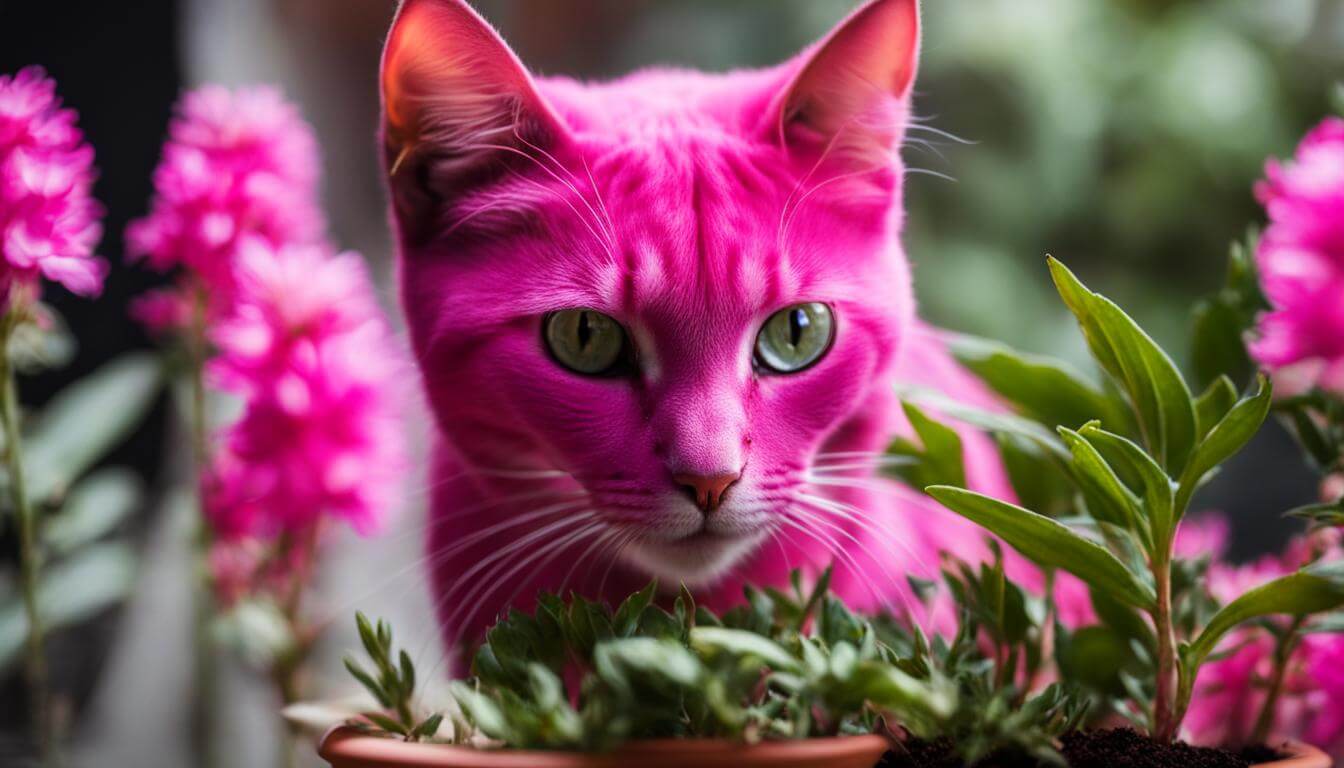Flaming Katy, scientifically known as Kalanchoe Blossfeldiana, is a popular houseplant native to Madagascar. It belongs to the Kalanchoe genus and is known for its vibrant flowers that bloom in various colors, including red, yellow, pink, orange, and white. While Flaming Katy is a beautiful addition to any home, it’s important for pet owners to be aware that some parts of the plant are highly poisonous to cats and dogs if ingested. Symptoms of toxicity can include vomiting, diarrhea, excessive salivation, loss of coordination, and in severe cases, seizures. If you suspect your pet has ingested Flaming Katy or is displaying any unusual symptoms, it is crucial to seek veterinary care immediately.
Key Takeaways:
- Flaming Katy, or Kalanchoe Blossfeldiana, is considered poisonous to cats.
- The flowers of Flaming Katy contain the highest levels of toxins in the plant.
- Ingesting Flaming Katy can cause symptoms such as vomiting, diarrhea, and excessive salivation in cats.
- Keep Flaming Katy out of reach of cats and contact a veterinarian if ingestion is suspected.
- Being proactive and knowledgeable can help keep cats safe and healthy in the presence of Flaming Katy.
The Toxicity of Flaming Katy to Cats
Flaming Katy, also known as Kalanchoe Blossfeldiana, is a highly poisonous plant for cats. The American Society for the Prevention of Cruelty to Animals (ASPCA) warns that the entire plant contains toxins, with the flowers being particularly dangerous. If a cat ingests any part of the plant, it can lead to vomiting, diarrhea, and excessive salivation. In severe cases, the cat may experience loss of coordination or even seizures. Therefore, it is crucial for cat owners to be aware of the potential risks and take necessary precautions.
The toxicity of Flaming Katy is attributed to the presence of calcium oxalate crystals, also known as Sweetheart. These crystals can cause gastrointestinal upset and can be harmful when ingested. Even minor contact with the sap of the plant can result in adverse effects. Therefore, it is important to keep Flaming Katy out of reach of cats and to contact a veterinarian immediately if ingestion or exposure occurs.
It’s worth noting that Flaming Katy is not only toxic to cats but also to dogs and other pets. The severity of the toxicity can vary, with some species of the Kalanchoe Blossfeldiana being extremely toxic to dogs. As a responsible pet owner, it is essential to ensure the safety of your pets by keeping toxic plants like Flaming Katy away from their reach. If you suspect that your cat has ingested Flaming Katy or is showing signs of toxicity, do not hesitate to seek veterinary care immediately.
| Symptoms of Flaming Katy Toxicity in Cats | Precautions for Cat Owners |
|---|---|
|
|
Remember, the well-being of our pets is our responsibility. By educating ourselves about the potential dangers of plants like Flaming Katy and taking appropriate measures to keep our pets safe, we can ensure their health and happiness.
Keeping Your Cat Safe Around Flaming Katy
As a responsible pet owner, I understand the importance of keeping my cat safe from potential hazards. Flaming Katy, also known as Kalanchoe, is a popular houseplant that can pose a risk to cats due to its toxicity. To ensure the well-being of my furry friend, I take certain precautions when it comes to Flaming Katy.
First and foremost, I keep Flaming Katy as an indoor plant, away from the reach of my cat. By doing so, I minimize the chances of accidental ingestion and potential gastrointestinal upset. Cats are curious creatures, so it’s crucial to place the plant in a location where my cat cannot access it if I decide to keep it outdoors.
If I ever suspect that my cat has ingested Flaming Katy or is displaying any signs of toxicity, I don’t hesitate to contact my veterinarian immediately. Time is of the essence when it comes to addressing potential health issues in cats, and professional guidance is essential in such situations.
By being proactive and taking the necessary precautions, I can create a safe environment for my cat around Flaming Katy. Keeping the plant out of my cat’s reach, whether indoors or outdoors, and seeking veterinary care promptly if needed, ensures the health and well-being of my feline companion.
FAQ
Is Flaming Katy toxic to cats?
Yes, Flaming Katy (Kalanchoe Blossfeldiana) is considered poisonous to cats. If ingested, it can result in harmful effects.
What are the symptoms of toxicity in cats?
Symptoms of Flaming Katy toxicity in cats can include vomiting, diarrhea, excessive salivation, loss of coordination, and in severe cases, seizures.
What should I do if my cat ingests Flaming Katy?
If you suspect your cat has ingested Flaming Katy or is displaying any unusual symptoms, it is crucial to seek veterinary care immediately.
How can I keep my cat safe around Flaming Katy?
To ensure the safety of your cat, keep Flaming Katy out of reach, both indoors and outdoors. If you suspect ingestion or gastrointestinal upset, contact your veterinarian immediately.
Can Flaming Katy be harmful to dogs?
Yes, Flaming Katy is also considered toxic to dogs if ingested. The same precautions should be taken to keep dogs safe around the plant.
Is Flaming Katy safe for cats?
Flaming Katy is toxic to cats and should be kept out of their reach to ensure their safety and well-being.







